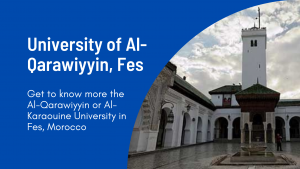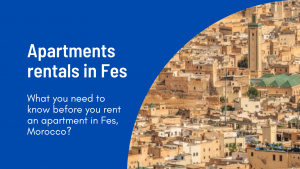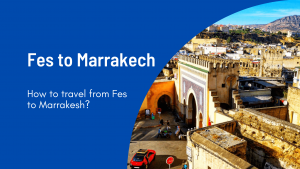This section of Morocco Tours Agency is dedicated to transport in Morocco, how to move within the country. Therefore, if what you are looking for is information on how to travel here from your place of origin, in this article we analyze the different options for bus, train, plane, car, etc.
Regarding transport in Morocco, we have distinguished six different means: the bus, the train, the plane, the taxi, the car (private or rented), and the agency minivan with driver. In the following lines and on the different pages of this section you will find all the details you need to know.
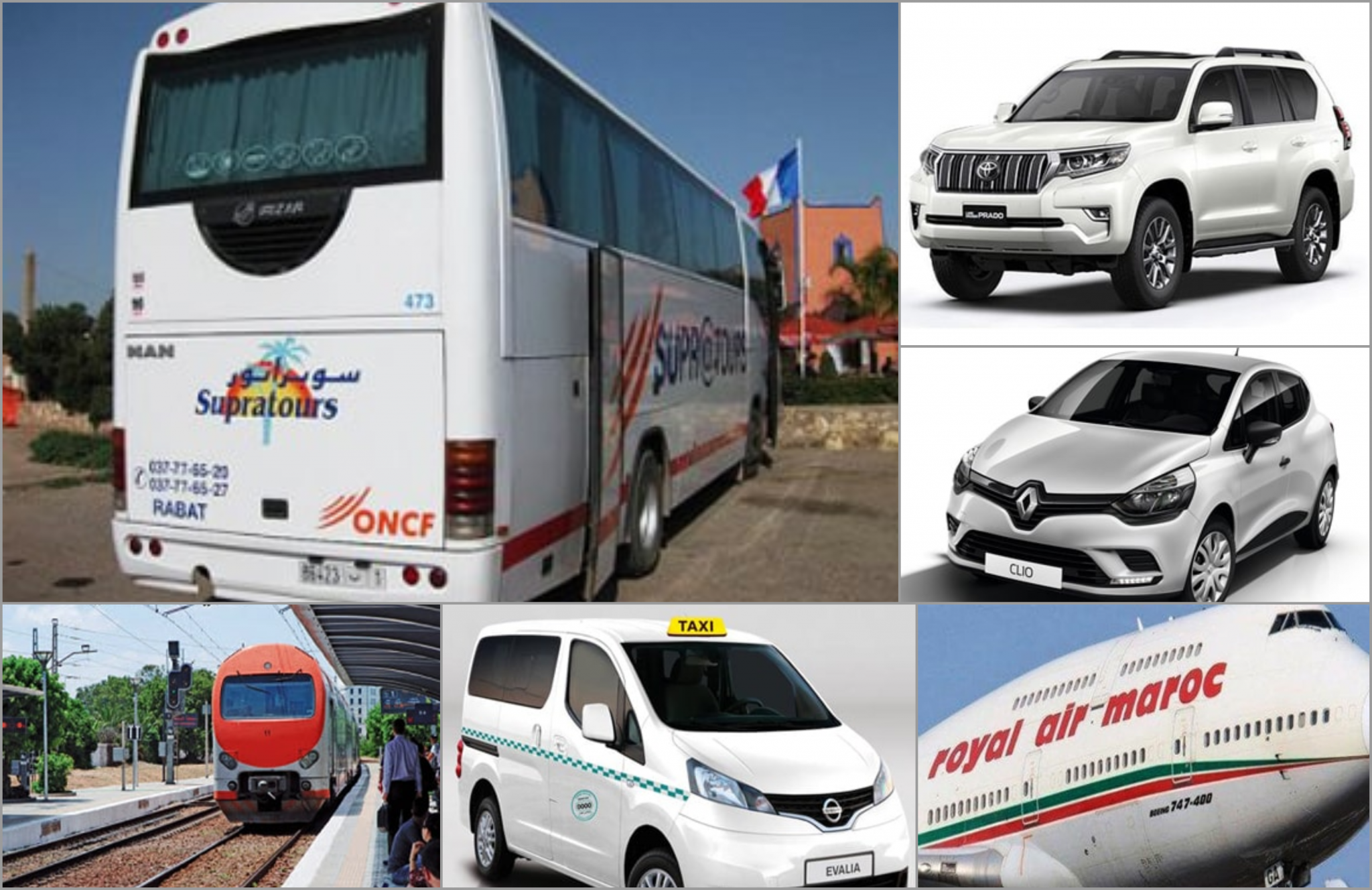
We design the trip you are looking for and include accommodation, private transport in Morocco, English-speaking driver/guide, and activities according to your preferences. You just have to explain to us what you would like to do and based on the time available we advise you to close the tour and make a custom budget.
1. Public Transport in Morocco
Public transport in Morocco is generally quite good. Regarding the train, the National Office of Railway Chemists (ONCF) of Morocco manages one of the most modern railway systems on the African continent, which connects most of the country’s main urban centers. It is, therefore, an interesting solution to the question of how to get around Morocco, since it is comfortable and economical, especially between the main cities, such as Marrakech and those of the north and the Atlantic coast.
The other great alternative in public transport in Morocco is the bus, although, in reality, it is not a public service offered by the Administration but a collective service managed by private companies. Its fleet has been greatly modernized in recent years and reaches all corners of the country. Larger cities have public bus services and the average ticket price is 4 dirhams.
Those who have little time and want to know how to move around Morocco faster between cities far from each other can try the other great collective means: the plane since there are different internal flights between its main cities. However, in this way, certain sensations and experiences that we can live in other means of transport are lost, such as the changes of landscape on the other side of the window.
On the other hand, the barcode is not a solution to how to get around Morocco, since its routes do not connect two Moroccan cities, but a foreign place with a local destination. In other words, it is a very interesting option to travel to Morocco but not for internal displacement.
2. Private Transport in Morocco (recommended)
Private means are an interesting transport option in Morocco, especially for tourists. They are used without adjusting to predefined departure and arrival times and offer greater freedom and flexibility. All of them run by road: the taxi, the private car (rented or owned), and the minivans or microbuses of agencies such as MoroccoToursAgency.com.
If you want to enter Morocco with your own car, you will have to board it on a ferry to cross the Strait of Gibraltar. On the How to get page, we tell you how to do it and what procedures are required by the border authorities. Once you drive on Moroccan soil with your own car, we recommend you take extreme precautions, as the driving style is different and the signs are in languages other than yours.
Renting a car is a more expensive option than public transport in Morocco and will force you to plan the route in advance in order to get to your destination well. But, like traveling with your own vehicle, it can also simplify the longer routes, which are often lengthened by their number of stops or because they are difficult to do with local means, as they involve numerous changes and waiting.
Large rental companies operate here, so their operation will be familiar to you. In any case, it is possible to negotiate a more convenient price if you ask at local small car rental companies.
Small taxis (Petit Taxi) are common in most cities and large towns. They are authorized to carry up to three passengers and can be a good way to avoid scammers.
Large taxis (Grand Taxi) are those that are used for intercity trips and are usually hired through prior negotiation of the price to pay. They are larger vehicles, usually of the Dacia brand, with a capacity for 6 people.
And finally, there is the most comfortable and safest option of all: the private vehicle with a driver. Whether it is normal tourism, a minivan, or even a minibus for Median groups, it is a service that allows the traveler to concentrate on enjoying their trip, without worrying about the route, the roads, the parking lots, or any other detail.
At Morocco Tours Agency we are specialists in this, always providing you with an English-speaking driver. You can contact us to know more details about this means of transport in Morocco and organize your Morocco tour with it.
Here are the 6 Means of Transport in Morocco
1. Buses: Morocco, like any Moroccan
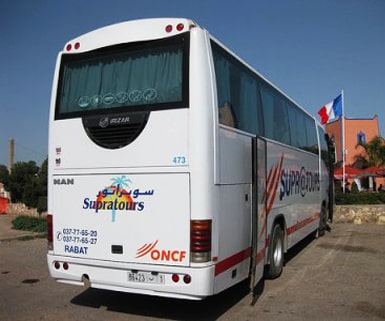
If traveling by bus is not a problem for you, Morocco is a country where you can travel from one city to another. It is without a doubt the most widespread public transport. At least, wherever we find asphalt because on the sand the kings are the 4×4 vehicles… and the camels!
The main bus company in Morocco is CTM: it has the largest and most modern fleet of vehicles. Therefore, they are the most comfortable when traveling, although they are also somewhat more expensive than those of other companies. This company manages the service between Moroccan cities and abroad, which is why we have included it as one way to get to Morocco from other countries. CTM also provides long-distance night service between large cities.
But CTM is not the only bus company: Morocco has other private companies that offer tourists vehicles with air conditioning and a TV. Some of these private companies are Supratours, Flandria, and Trans Ghazala, the latter with regular lines. They stand out for their comfortable coaches, with wide coverage, and at good prices. The prices of bus tickets in Morocco vary according to the distance, between 20 and 250 DH, plus approximately 7 DH for each suitcase, depending on the weight.
If you miss a train or travel to a city where the rail network does not arrive, buses are not an option to rule out at all: the network is dense and efficient in most areas. In addition, it has the advantage of being the cheapest form of transport (approximately 20% cheaper than the train). On the other hand, it represents the best way to get to know the country in-depth, since it reaches countless populations and allows the traveler to mix with the local people.
But although it is the cheapest way, it is also slower and more uncomfortable than the train: some routes become real torture due to the limited space available between the seats … if you are lucky enough to find a free seat, it is not always It succeeds, forcing the traveler to remain standing throughout the journey.
2. Car with driver in Morocco: recommended
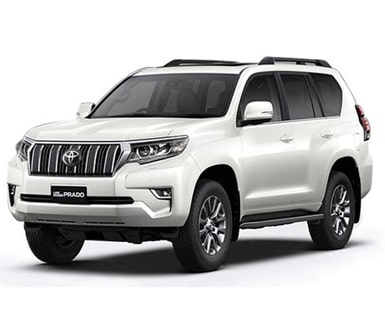
In addition, MoroccoToursAgency.com is in charge of obtaining and managing this service for our clients, with English-speaking drivers for greater comfort. All our vehicles are modern, A/C and very comfortable. Don’t hesitate to get in touch with us for more information.
2.1. How is the car service with drivers in Morocco?
The car service with drivers in Morocco works like in any other country in the world. That is, it is a private vehicle, without a taximeter but with a professional driver, hired for a certain period of time, with a predetermined route and conditions (mileage, hours of driving, intermediate cities, etc.), to be agreed between the agency and the client.
In general, there are three types of vehicles that can be hired for this service:
A passenger car, usually a saloon type, with a capacity for four passengers + the driver. It is characterized by ample interior space for each passenger, with highly comfortable seats. In addition, it has a generous trunk, with the capacity for the luggage of all users. They are usually higher-end models.
A minivan, with a capacity of seven passengers + the driver. It is an ideal solution for small groups of friends or large families who want to travel together and with their luggage in the trunk, which has more capacity than a tourist.
Minibus, with a capacity of 17 people, is ideal for medium-sized groups, such as associations, large groups of friends, and even circuits with passengers of heterogeneous origin (that is, who have purchased the package from an agency independently of each other and without previously known). It is easy to maneuver on a practical level, allowing to safely travel conventional roads of the ‘deep Morocco’, where a coach of more than 50 people would encounter serious difficulties.
To these three options, we should add another possible car with a driver in Morocco: the 4×4 or off-road vehicle. It is a vehicle widely used in the country and by our own agency, since we organize tours on unpaved tracks, especially in the desert area, where this is the only compatible means of transport.
Well, the latter is not entirely accurate: you can also use 8×8 vehicles, that is, camels! And MoroccoToursAgency.com is also in charge of managing your reservation to go on their backs through the desert dunes…
3. Train: Morocco and its railway system
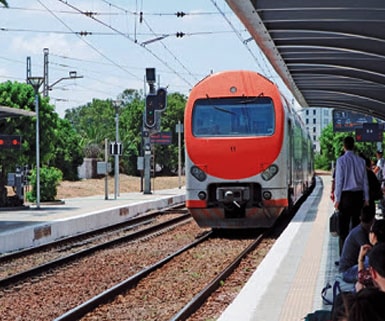
The train, in Morocco, is the most recommended public service. Mainly for its speed, comfort (which includes air conditioning), and punctuality. The railway network links all the country’s important cities, such as Marrakech, Fes, Tangier, Casablanca, Rabat, etc. To cover long journeys, it is a more suitable option than buses, since they even offer the possibility of sleeping in bunks on many of the night trips.
Train stations in Morocco are usually located in modern areas of cities, very close to bus stations to facilitate the change from one form of transport to another.
The train network in Morocco connects the cities of Tangier and Marrakech, branching out to the city of Oujda in the north and forming another line scheme in the south, from Casablanca to Jadida and Safi.
This network is made up of fast trains (such as the Casablanca – Rabat train), other more traditional and slower trains, and a third mixed system, used in the south, where for geographical reasons the bus and the train are combined and can be used with a single ticket.
Train lines in Morocco usually have several daily departures and are considerably cheaper than trains in Europe. You can buy the train tickets through the web.
3.1. Types of Train Tickets in Morocco
When buying a train ticket in Morocco, the class of the seat must be taken into account, since these offer different degrees of comfort and accessibility. There are generally three classes:
Couchette: this is the most expensive ticket, for offering the most comfortable form of travel. It has cabins with bunk beds and air conditioning. The couchette is especially recommended if the trip is long distance or the journey is at night.
First Class: This is a recommended way to travel on shorter routes. The seats are comfortable and pre-assigned, and the cars are air-conditioned.
Second Class: This is the normal ticket and they are offered on a first-come, first-served basis. Due to this, passengers may be limited in terms of seats.
As we said, there is the combined train + bus ticket. It is, for example, the one offered by the Supratours bus company. They are used to travel to places where the train does not arrive so that the last stage of the trip (or the first, in reverse) is carried out by the road.
To illustrate the information on this page, check the ONCF or Supratours website for the current exact price.
4. Petit Taxi and Grand Taxi in Morocco
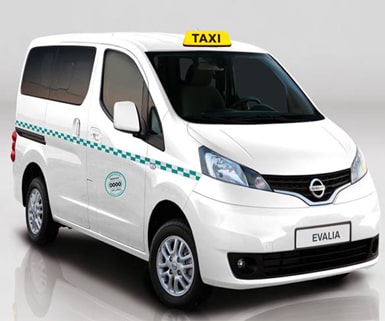
The taxi represents a very common transport service and used by the Moroccans themselves in both their petit taxi and grand taxi modes. But they are also a great way of sightseeing, allowing you to optimize times, get in touch with local people and comfortably access monumental places.
In recent years, Morocco has been investing a lot in this sector, providing incentives for taxi drivers to renew their vehicles.
The most common in these cases is being the replacement of the old Mercedes by new vehicles of the Renault brand, which guarantee greater safety in transfers. Gone are the times when the country’s mobile park was made up of more than 55,000 old Mercedes, although it is still possible to find some on the road.
There are two types of taxis as means of transport in Morocco: the petit taxi and the grand taxi, each with its characteristics and particularities. We analyze them below.
4.1. The petit taxi, for short trips
The transport in Morocco is not complete without the petit taxi, it is the one that makes the urban journeys and, therefore, the shortest. They are distinguished because their color is very vivid, changing from one city to another: in Fes, they are red, in Tangier light blue, etc.
The most common model for this type of vehicle was the Fiat 1, although there is currently a greater diversity of models. All of them are small cars, compact or urban cars, and generally, with a capacity for three people.
In this way, if you are a group of more than three people, you will have to take two petit taxis or look for a grand taxi ready to make this trip. There are no stops for these urban taxis, so you can call him on the street when you see him go by, gesturing with his hand. They usually meet around bus and train stations. The price of a petit taxi is very cheap for a European pocket, making it a fantastic option for trips within the city.
4.2. The grand taxi, for intercity trips
The grand taxi is used for trips between different cities, or for urban journeys when the number of passengers is between four and six people. As we mentioned, the most common brand for this type of taxi was the Mercedes, specifically the 200 Series models, which are large in displacement.
The color of these taxis depends on the city to which they belong, although the most widespread was light brown or brown. The grand taxi does not have a meter, so you have to negotiate the price before starting the trip. Its capacity is six people although it is not uncommon to see four people in the rear seats and up to three in the front.
These vehicles are easily recognized because they have a small sign on the roof and a stamp drawn on the doors indicating the province. Their prices are somewhat higher than that of buses and petit taxi, but they are also faster than both modes of transport.
4.3. Tips for Taking a Taxi in Morocco
If you decide to travel by taxi in Morocco, it is worth taking into account a series of tips, especially for grand taxis, since they lack a meter and their drivers, like in many other countries, are usually very smart.
A first recommendation is to be informed of how much a certain journey costs more or less. This will give you a position of greater self-confidence in order to reach a good agreement for your interests in the aforementioned initial negotiation.
Another tip for those who want to travel more comfortably is to pay for all taxi seats. Otherwise, you will have to wait for all the seats in the vehicle to be filled to start the journey and, once you have started the journey, you will experience greater tightness. Normally up to six people travel, although the cars are for four passengers and a driver.
In the case of the petit taxi, you have to be very careful so that the driver, in fact, activates the meter and there are no surprises at the end of the journey. If he refuses, agree on a price before starting the trip, taking out your negotiating skills.
Another option is to get out of the vehicle and look for another taxi that does have a meter. The approximate rate for a short trip through the city is from 10 to 25 DH, although it usually increases after 20.00.
5. Private Vehicle & Car rental in Morocco

Morocco is a country that offers its visitors a wide range of experiences. From the natural wonders of its deserts to the magnificent Atlas Mountains, through its exotic beaches.
You will also find picturesque villages and charming kasbahs. And one of the best ways to get around everywhere is through a private vehicle or a car rental service in Morocco, which is open to all types of tourists with a driving license.
That freedom is even greater if it is your private car since you will not depend on collection or return offices. Nor will you have to worry about how the deposit level is at the end of the trip.
If this is your favorite option, we recommend you read more on Necessary documentation, where we explain what procedures you will have to carry out in order to take a ferry and cross the Strait of Gibraltar with your vehicle, since in reality, this is the main complication for those who they encourage driving in Morocco with their own car.
However, more and more people are deciding to spend their holidays in this country in this way, allowing them to move through all cities without strings attached.
5.1. How Car rental in Morocco works?
Now, if you want to drive in Morocco but want to leave your car at home, you have the option of renting a vehicle. It is a widely spread service, especially in large cities and tourist vacation spots. You will find offices in airports, in train and bus stations, next to the historic center of big cities, in the vicinity of large coastal resorts, etc.
You will not have any problem finding car rental companies in Morocco, as large international companies operate here, such as Europcar, Avis, or Hertz. The reservation format is the same as in other countries: it can be done online from their respective web pages, indicating mileage, desired model, number of days, etc.
It can also be done in person in the office. The minimum requirements that are usually applied for are having a driving license (sometimes with a minimum age of one or several years), having a valid passport, and taking out an insurance policy.
You can also look for local companies dedicated to car rental in Morocco, as they usually offer a slightly lower price than the mentioned international companies. In any case, this rental service is precisely cheap, comparing its rates to those of your USA and UK or even to those of other European countries.
5.2. Traffic regulations for driving in Morocco
Opt for your private vehicle or a car rental in Morocco, you will need to know some basic questions to circulate on the country’s roads. For example, regarding the basic rules:
- Seat belt: mandatory on all occupants
- Circulation side: on the right
- Maximum speed in the city: between 40 and 60 km/h
- Maximum speed on two-way roads: 90-100 km/h
- Maximum speed on highways and freeways: 120 km/h
Logically, these speed limits can vary according to the road, so you have to be very careful with the signs. And even more, if we take into account that the Moroccan police are very ‘friendly’ to put instant fines for speeding, especially if they find the backing of one of the many mobile radars they have in operation: if they consider that your vehicle was circulating only for 1 km/h above what is allowed, the fine will be effective almost certainly.
Road signs follow the international model, in matters such as Stop, Yield, priorities, etc. When the sign includes letters or words, the country’s two official languages are usually used: Arabic and French, with their respective alphabets.
As an extra rule when driving in Morocco, you must be very attentive to pedestrians, bicycles, motorcycles without lights, and animals with cargo, since they often use the road and it is difficult to see them, resulting in a danger to keep in very consider.
If you are going to drive in Morocco, you will be able to find local police controls, both breathalyzer, and drug trafficking. They are usually located in almost all the entrances and exits of the population, and they can also give you the stop to deliver a complaint about speeding.
6. Plane in Morocco: internal flights
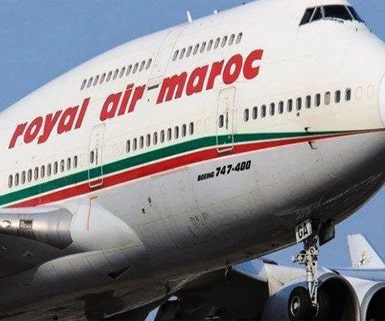
Taking a plane in Morocco can be an interesting solution to quickly travel between two cities far from each other. Of course, it is a comfortable and safe environment, although with it you lose part of the charm of traveling on the road, where you can see how the landscape changes through the window.
6.1. Morocco Airports
Morocco’s airports, as in all countries, differ between national and international. The latter is larger, with longer runways and take-offs, adapted to international regulations, and suitable for large aircraft operations, such as the large-capacity models from Boeing and Airbus.
Nationals, on the other hand, tend to be smaller in size, oriented to domestic flights, in many cases with charter or small aircraft service. For more info about Morocco airports please check this list.
In addition to these, there are the aforementioned national airports, which we do not address here because they are not of special interest to tourists since they are used for non-commercial purposes: military, logistics, official travel, etc.
In most commercial airports there are, of course, transfer services, such as express buses and taxis.
6.2. An Airplane in Morocco, for internal travel
Although flying to this country from abroad is the most comfortable for most tourists, the only direct way of travel for those who come from very distant places: Northern Europe, the American continent, the Middle East and Far, etc.
However, you can also take a plane in Morocco for internal travel. The company in charge of operating these national lines is Royal Air Maroc or its subsidiary Royal Air Maroc Express.
When taking a plane in Morocco, all international safety standards in personal documentation and boarding must be respected.
Conclusion: Transport in Morocco
Ultimately, we hope that you find this article about transport in Morocco helpful and useful. Our aim as locals is to put every visitor to Morocco on the right path so he can tour and explore the country in his preferred way and in a carefree and peaceful.

